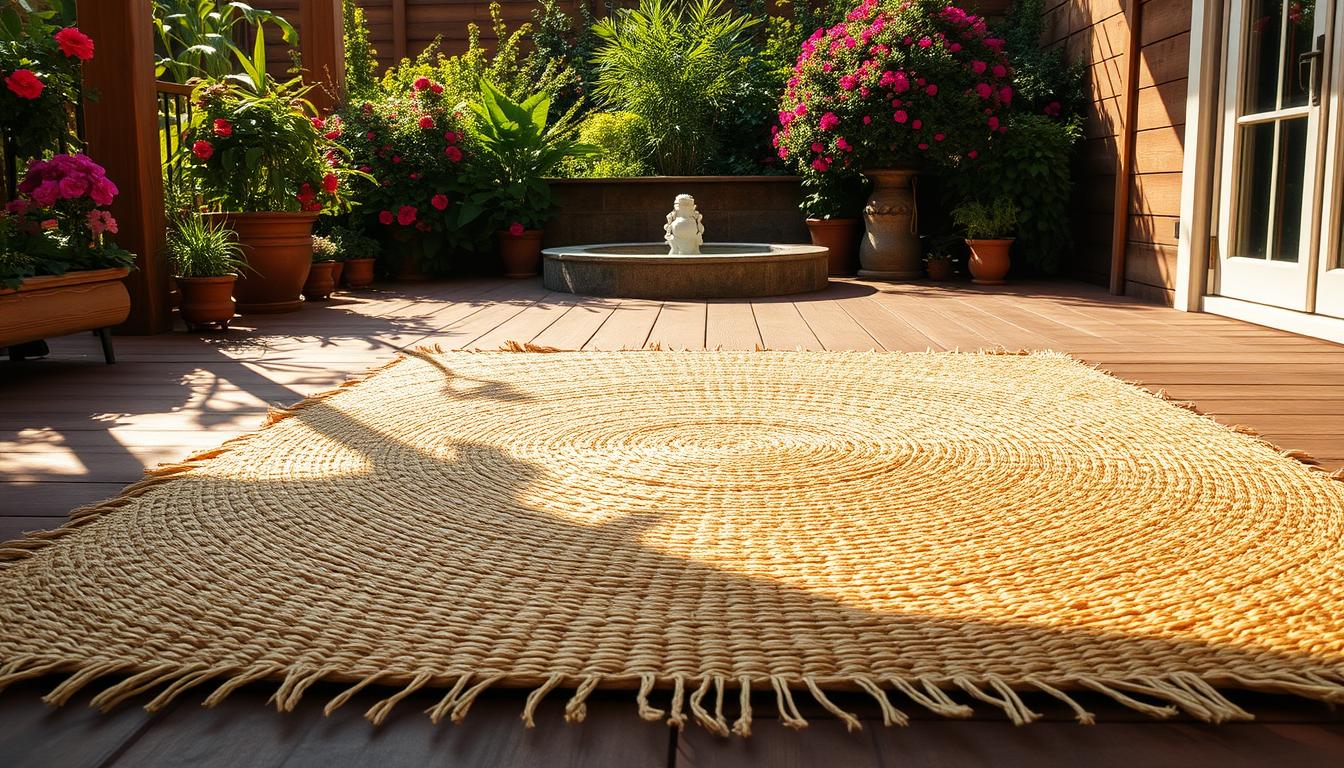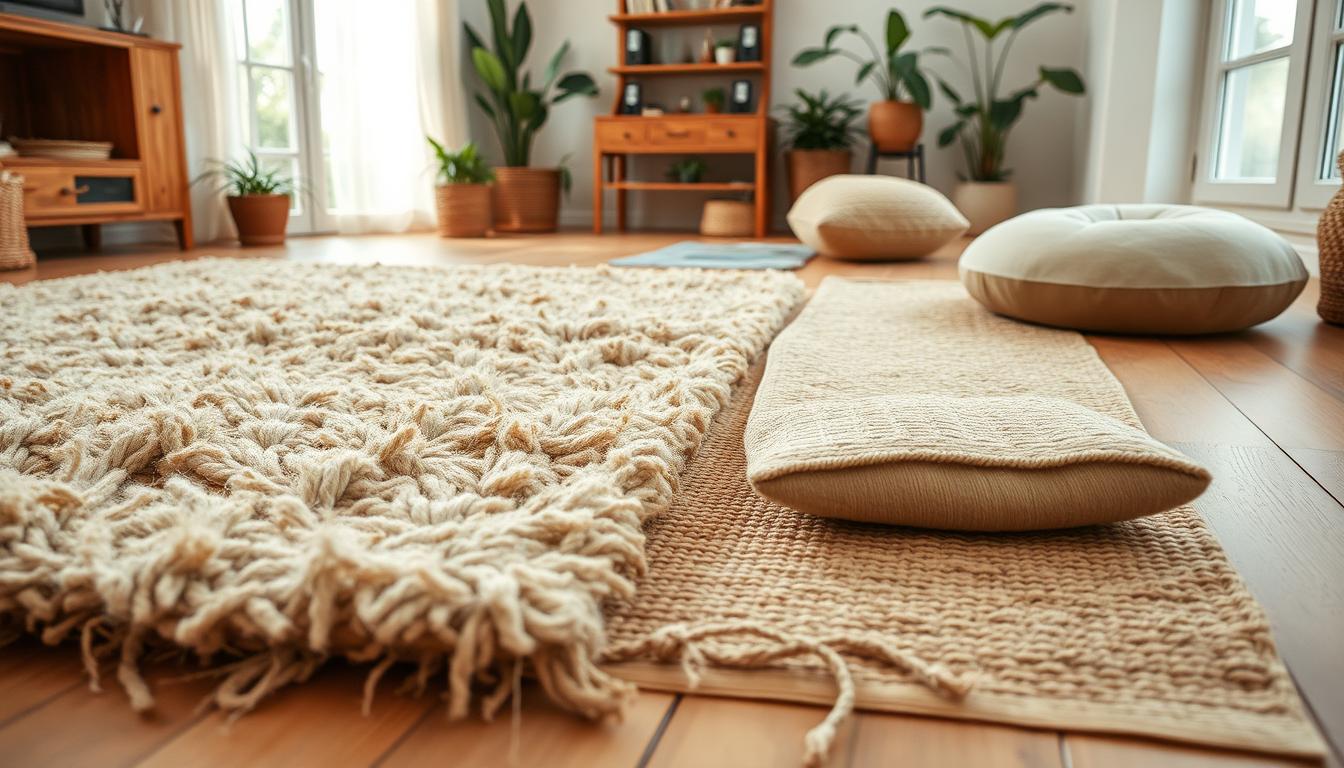
5 Reasons Sisal Rugs Work Outdoors

Imagine stepping onto a patio that blends rustic charm with modern resilience. While synthetic options dominate outdoor decor, natural materials like sisal offer surprising potential for covered spaces. Derived from the Agave plant’s sturdy leaves, these textured floor coverings bring organic warmth to screened porches or sheltered decks.
Their neutral tones complement any design style, from coastal retreats to desert-inspired lounges. Unlike plastic-based alternatives, sisal’s natural fiber rugs age gracefully, developing a patina that tells your space’s story. But success hinges on placement—think dry areas shielded from rainstorms and intense sunlight.
Why consider this eco-conscious choice? Sisal withstands moderate foot traffic while resisting dust and dirt. Its breathable structure prevents moisture buildup in shaded zones. Pair it with weather-resistant furniture for a look that bridges indoor comfort with outdoor freedom.
Ready to discover how these plant-based wonders elevate your alfresco living? Let’s explore five compelling reasons they might just redefine your exterior aesthetic.
Key Takeaways
- Sisal thrives in covered outdoor areas like patios or balconies with limited moisture exposure
- Natural texture adds earthy elegance to modern or rustic design schemes
- Biodegradable materials support sustainable home decor choices
- Regular maintenance extends lifespan in semi-protected environments
- Not suitable for fully exposed locations due to weather sensitivity
Understanding Sisal Rugs for Outdoor Spaces
Picture a material born from sun-baked agave leaves, transformed into floor art that marries strength with organic charm. Sisal’s journey begins with the Agave Sisalana plant, whose sword-like leaves yield remarkably tough fibers perfect for weaving resilient textiles. These natural wonders thrive in arid climates, maturing faster than most renewable resources while demanding minimal water.
What Makes Sisal Rugs Unique?
Unlike synthetic counterparts, each strand tells a story of sustainability. Artisans flat-weave the fibers into dense patterns that withstand foot traffic without losing their earthy appeal. The surface varies from sleek to nubby textures, letting you pick a tactile experience that suits your outdoor vibe.
Farmers harvest mature leaves by hand, sun-bleaching them to enhance durability. This process preserves the material’s breathability—a key advantage in shaded patios where airflow matters. Discover how these natural fiber options outperform mass-produced mats through sheer resilience.
Eco-Friendly and Durable Characteristics
Every rug represents a closed-loop cycle. After serving your space for years, it decomposes naturally without harming ecosystems. The fibers’ inherent abrasion resistance means fewer replacements—ideal for eco-conscious homeowners seeking long-term solutions.
Top-grade sisal from Tanzania and Brazil boasts unmatched tensile strength, outlasting many plant-based alternatives. Its neutral hues blend effortlessly with wicker furniture or stone surfaces, creating cohesive designs that age like fine leather. While not indestructible, proper care ensures years of textured beauty in covered outdoor zones.
Can Sisal Rugs Be Used Outdoors?
Natural fibers bring earthy sophistication to outdoor spaces, but their performance depends on strategic placement. When considering textured floor coverings for semi-protected zones, understanding their capabilities ensures lasting enjoyment.

Strengths Worth Celebrating
These plant-based textiles shine in dry, shaded environments. Their breathable structure resists dust accumulation while adding organic texture to covered patios. Hypoallergenic properties make them family-friendly choices, especially around pets or children.
The material’s sustainable origins appeal to eco-conscious homeowners. Unlike plastic mats, they decompose naturally without harming ecosystems. Pair them with weather-resistant wool options for layered durability in transitional spaces.
Critical Limitations to Acknowledge
Water exposure remains the greatest threat. Even morning dew can seep into fibers, creating musty odors over time. Direct sunlight gradually bleaches vibrant neutrals into faded versions of their original charm.
Stain resistance proves minimal compared to synthetic counterparts. A spilled drink becomes an urgent cleanup task rather than a minor mishap. For fully exposed decks, specialized outdoor rugs often outperform natural alternatives.
With thoughtful placement and realistic expectations, these textured accents elevate sheltered entertaining areas. Rotate them seasonally and store during heavy rains to preserve their rustic appeal.
Ideal Conditions and Outdoor Maintenance
Transform your outdoor living area with smart placement strategies that protect natural fiber accents. Covered porches, screened balconies, and shaded patios create the perfect stage for these earth-friendly textiles to shine. Proper protection ensures your floor covering thrives in semi-exposed spaces.

Optimal Outdoor Setups for Sisal Rugs
Covered spaces like three-season rooms or vaulted verandas offer essential shelter. Always use a waterproof underlay beneath your floor covering—this barrier prevents ground moisture from creeping upward. Position furniture legs on coasters to distribute weight evenly and prevent indentations.
Steer clear of pool decks or garden pathways where sprinklers might dampen fibers. For windy locations, secure edges with double-sided rug tape designed for outdoor surfaces. Explore breathable sisal options that handle moderate foot traffic while maintaining their organic appeal.
Maintenance Tips to Preserve Durability
Vacuum weekly using a brushless attachment to lift dirt without fraying strands. Blot spills immediately—water left standing more than five minutes risks staining. Rotate your textile every three months to ensure even sun exposure in partially shaded areas.
Apply a plant-based protector spray annually to repel light moisture. For stubborn debris, use dry cleaning methods recommended by outdoor rug specialists. Store during monsoon seasons or extreme weather to extend your investment’s lifespan.
Exploring Alternatives for Outdoor Areas
What if your outdoor space needs more weather resistance than natural fibers provide? Today’s market offers innovative materials balancing style and durability for every climate.
Synthetic Fibers vs. Natural Fiber Options
Polypropylene rugs lead synthetic choices with UV-proof weaves that laugh at rainstorms. These hardy alternatives keep colors vibrant under harsh sunlight while shrugging off spills. For earth-friendly textures, jute delivers a cozy feel in covered zones—just avoid humid climates where fibers weaken.
Comparing Polypropylene, Jute, and Other Materials
Bamboo mats mimic natural charm while fighting moisture better than most plant-based options. Recycled plastic weaves turn bottles into weather-warrior floor coverings that survive poolside splashes. Though jute rugs add rustic flair, their softness demands sheltered placement like porches or sunrooms. Explore eco-friendly alternatives matching your space’s personality and practical needs.
FAQ
Are natural fiber rugs suitable for covered patios?
Yes! Natural fibers like sisal or jute can work in covered outdoor spaces with limited moisture exposure. Ensure they’re placed under a roof or awning to minimize rain contact and direct sunlight.
How do synthetic materials compare to sisal for outdoor use?
Synthetic options like polypropylene resist water, mold, and fading better than natural fibers. However, sisal offers unmatched texture and organic beauty—ideal for dry, shaded areas where durability meets design.
What steps protect natural fiber rugs from weather damage?
Apply a fabric protector spray to repel spills, and avoid placing them in high-traffic zones. Rotate the rug periodically to ensure even wear and dry it immediately if exposed to moisture.
Can these rugs handle pet-friendly outdoor spaces?
While sisal’s texture is pet-friendly, its natural fibers may trap odors or stains over time. For homes with pets, consider stain-resistant alternatives like recycled plastic or indoor/outdoor polyester blends.
Which climates are best for natural fiber rugs outdoors?
Dry, mild climates with low humidity are ideal. In rainy or humid regions, opt for synthetic materials that won’t warp or develop mildew. Always prioritize airflow to extend the rug’s lifespan.
How often should outdoor rugs be cleaned?
Shake out debris weekly and spot-clean spills promptly. For deeper cleaning, use a mild soap solution and let the rug dry completely before reuse. Avoid harsh chemicals that weaken natural fibers.









